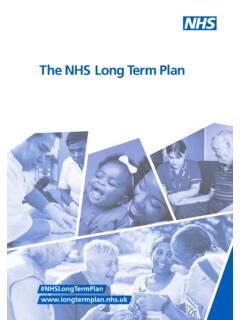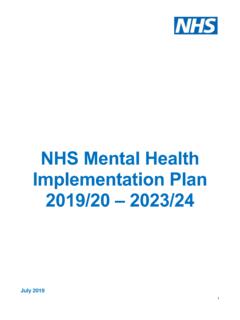Transcription of NHS Long Term Plan Implementation Framework
1 NHS long Term plan Implementation Framework June 2019. Contents 1. Introduction to the NHS long Term plan Implementation Framework .. 3. 2. Delivering a new service model for the 21st century .. 7. Transformed out-of-hospital care' and fully integrated community-based care .. 7. Reducing pressure on emergency hospital services .. 9. Giving people more control over their own health and more personalised care .. 9. Digitally-enabling primary care and outpatient care .. 10. Better care for major health conditions: Improving cancer outcomes .. 10. Better care for major health conditions: Improving mental health services .. 11. Better care for major health conditions: Shorter waits for planned care .. 13. 3. Increasing the focus on population health .. 14. 4. More NHS action on prevention.
2 15. 5. Delivering Further progress on care quality and outcomes .. 16. A strong start in life for children and young people .. 16. Learning disabilities and autism .. 17. Better care for major health conditions .. 19. Cardiovascular disease .. 19. Stroke care .. 19. Diabetes .. 20. Respiratory disease .. 20. Research and innovation to drive future outcomes improvement .. 21. Genomics .. 22. Volunteering .. 22. Wider social impact .. 22. 6. Giving NHS staff the backing they need .. 23. 7. Delivering digitally-enabled care across the NHS .. 25. 8. Using taxpayers' investment to maximum 28. Financial and planning assumptions for systems .. 28. Improving productivity .. 29. Reducing variation across the health system .. 30. 9. Next steps .. 31. Annex A Funding the long Term plan .
3 33. Annex B: Financial assumptions for strategic plans .. 36. Annex C: LTP headline metrics .. 40. Annex D: Supporting wider social goals .. 42. 2 I NHS long Term plan Implementation Framework Introduction to the NHS long Term plan Implementation Framework The NHS long Term plan , published in January 2019, set out a 10-year practical programme of phased improvements to NHS services and outcomes, including a number of specific commitments to invest the agreed NHS five-year revenue settlement. This Implementation Framework sets out the approach Sustainability and Transformation Partnerships (STPs)/Integrated Care Systems (ICSs) are asked to take to create their five-year strategic plans by November 2019 covering the period 2019/20 to 2023/24. These plans should be based on realistic workforce assumptions and deliver all the commitments within the long Term plan .
4 This document does not repeat the rationale and commitments set out in the long Term plan . System plans will be aggregated, brought together with additional national activity and published as part of a national Implementation plan by the end of the year so that we can properly take account of the Government Spending Review decisions on workforce education and training budgets, social care, councils' public health service and NHS capital investment. The national Implementation plan will set out initial performance trajectories and programme milestones to deliver long Term plan commitments. Some of the commitments in the plan are critical foundations to wider change. All systems must deliver on these foundational commitments for both service transformation (Chapter 2) and system development (Chapter 3) in line with nationally defined timetables or trajectories, including the Government's five financial tests which are set out in Chapter 8, with proposed metrics included in Annex C.
5 Systems will also have substantial freedoms to respond to local need, prioritise, and define their pace of delivery for the majority of commitments (Chapters 4 and 5), but will need to plan to meet the end points the long Term plan has set. Plans should prioritise actions that will help improve the quality of, and access to, care for their local populations, with a focus on reducing local health inequalities and unwarranted variation. Ensuring that we back our staff (Chapter 6) and develop a digitised NHS (Chapter 7) will also be at the heart of local plans. The national and regional support that systems can draw on is signposted throughout this Implementation Framework alongside a number of nationally delivered activities to support local Implementation . It aims to reflect our new national operating model.
6 Our ambition is to better coordinate how national and regional teams are working together to provide support to systems, based on local needs. The Implementation Framework has been developed and tested with many of the stakeholders that were involved in developing the long Term plan . We have sought views from systems across the country to inform the development of the Implementation Framework . We have also engaged with stakeholders, including the NHS Assembly and partners from Local Government Association, NHS Providers, the NHS Confederation, Academy of Royal Medical Colleges, government and VCSE. organisations. Based on their feedback, we have focused this Implementation Framework on setting out what the NHS needs to deliver from 2020/21 through to 2023/24, including the national must dos', whilst leaving space for systems to set out NHS long Term plan Implementation Framework I 3.
7 How they will deliver and phase progress in line with local priorities. It does not repeat the asks of the 2019/20 Operational Planning and Contracting Guidance. An integrated approach to strategic and operational planning STPs/ICSs are expected to bring together members organisations and wider partners, adopting a common set of principles and leadership behaviours as they develop and deliver plans. In doing this, systems will be expected to ensure that their plans align with the following principles: Clinically-led: In practice this means that systems will need to identify and support senior clinicians to lead on the development of Implementation proposals for all long Term plan commitments that have clinical implications and on the totality of their plan . Locally owned: Build on existing engagement with local communities to ensure they can meaningfully input into the development of local plans.
8 Local government will be key partners to developing system plans and are asked to engage throughout the process. Similarly, the voluntary sector and other local partners, including representatives from the most marginalised communities who often experience the poorest health and greatest inequalities, should be involved. Support for this is available through the NHS Involvement Hub, the national resource pack and the nationally commissioned Healthwatch contract. Realistic workforce planning: The interim NHS People plan sets out the national context. Systems should set out realistic workforce assumptions, matched to activity and their financial envelope. Plans should also show the steps to be taken locally to improve retention and recruitment. Financially balanced: The outline business rules for planning are set out in Chapter 8 of this Implementation Framework , with supporting assumptions and financial allocations set out in Annexes A and B.
9 Systems need to show how they will deliver the commitments in the plans within the resources available. Local plans will need to include the financial recovery plans for individual organisations in deficit against specified deficit recovery trajectories (test 1), with actions to achieve cash releasing savings (test 2) including through the reduction of unwarranted variation (test 4) and how they will moderate growth demand (test 3). Plans should set out capital investment priorities for capital budgets being agreed through the forthcoming Spending Review (test 5). Delivery of all commitments in the long Term plan and national access standards: The long Term plan was based on an inclusive and thorough process that identified prioritised, costed interventions based on clinical evidence and patient and public views.
10 The long Term plan will be implemented comprehensively, with system plans setting out what their contribution to this will be. Plans which will cover the four-year period April 2020 to March 2024 will also need to set out how systems will continue to maintain and improve performance for cancer treatment, mental health and A&E, to the point at which any new standards proposed by the Clinical Review and accepted by Government are implemented. They should also set out how elective care activity will be increased to reduce elective waiting lists and eliminate 52+ week waits. Phased based on local need: Whilst the long Term plan must be delivered in full, this does not mean that all initiatives should be implemented simultaneously everywhere. National requirements for some foundational requirements have been set out in Chapters 2 and 3.









